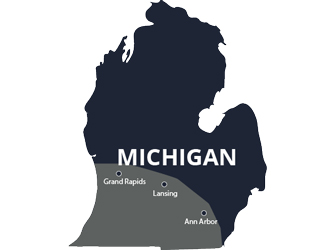In many parts of the country, including the Midwest, spring brings rainy weather, melting snow, and ice. While water is great for preventing summer drought, it can do more than just create a soggy lawn. Water saturation in the soil around your home can result in common foundation problems.
Signs
If you haven’t done anything over the years to protect your house’s foundation, it likely has water damage. Snowmelt landing next to the foundation, frost heaves, and saturation from seasonal rain all contribute to waterproofing issues with the foundation and/or basement walls.
Look for hairline or larger cracks in the floor’s concrete and basement walls. Also, check the outside of the foundation for cracks. Water spots are obvious indications that water has made its way through the porous concrete. Bowed basement walls and mold are also indicative of poor waterproofing.
Why are a few cracks or a water spot or two cause for concern? The foundation is the base of your home. Cracks threaten the integrity of the concrete. Spots mean water is leaking through the concrete because soil saturation is causing pressure against the foundation. You want your home to be as sturdy as possible. Foundation problems can lead to whole-home problems such as cracks in the ceilings, off-kilter doorways that make doors stick or not latch properly, cracked windows, and sagging floors.
Gutters
Gutters play significant parts in keeping spring rain runoff away from the foundation. Without them, water drips directly down, saturating the soil against the foundation. Keep gutters as clear as possible, and if you don’t have them, hire a reputable company to install them. Downspout should empty at least four feet from the house, preferably away from any driveways. If you already have gutters but the downspouts fall short, purchase extensions from a home improvement store.
Grading
Grading refers to the downward slope of land away from a structure. In the case of your home, it means your yard or the land around your foundation should angle slightly downward for some distance from the foundation. This plus gravity helps water flow away from the house, reducing the pressure against the foundation.
Landscaping
Landscaping can play a big part in channeling rainwater and snowmelt in the wrong direction. Roots from nearby trees and shrubs as well as flat flowerbeds can cause shifting soil, which can shift your foundation. Large tree roots can grow under the foundation, making gaps in the soil, which then fill with water and create slurries. Watery soil means there is nothing firm beneath your foundation to keep it from shifting.
Even if you’re planning on only planting smaller ornamental trees, make sure you plant them several feet from the house. For shrubs, install a root barrier three to five feet from the foundation. Any flowerbeds near the foundation should be raised. If you don’t want to go that route, plant flowers on sloped soil.
If you have vines covering the foundation, remove them. Vines can trap moisture against the concrete; this moisture can find its way through the concrete. Roots and tendrils can be insidious and creep into hairline cracks in the concrete, widening the cracks.
What to Do
When it comes to grading your land, a landscaping company can assist you. For crack repairs and other common foundation problems related to waterproofing and soil shifting, contact a company specializing in basements and foundations. Avoid hiring a general contractor; you want people dedicated to dealing only with that specific part of your home.
Acculevel Employees Have the Experience
Acculevel has been specializing in basement and foundation repair since 1996, and our staff has years of experience diagnosing problems and making recommendations. We won’t suggest a repair that isn’t essential to fixing your foundation or basement. If you live in the Midwest and would like to have a professional look over your foundation and provide a free estimate, give us a call at (866) 669-3349 or email us at office@acculevel.com.
Related Articles:
Prevent Mold During Healthy Lung Month in October
Foundation Repair 101: The Best Time of Year for Foundation Repair
Tips to Make Sure Your Home is in the Best Condition for the New Year
Tips to Make Sure Your Sump Pump Is Ready for Spring



















